Disinfect Hardwood Floors? (3 Steps to Sanitize!)
And let me tell you, they’re not just about looking good. Keeping them clean, and yes, even disinfected, is super important.
So, let’s dive into why and how you can sanitize those beautiful planks!
Introduction: The Aesthetic Appeal
of Hardwood Floors
Hardwood floors. Ah, the timeless beauty! They bring a certain warmth and elegance to any home, don’t they?
I’ve installed countless floors in my career, and it always amazes me how the right finish and color can completely transform a space.
From the classic oak to the exotic Brazilian cherry, there’s a hardwood to complement every interior design style.
But here’s the thing: it’s not just about the looks. Maintaining that beauty is also about hygiene and health.
Think about it, your floors see a lot of action. That’s why disinfecting them is more important than ever in today’s world!
Section 1: Why Disinfecting Hardwood
Floors is Essential
Okay, so you might be thinking, “Disinfect my hardwood floors? Is that really necessary?”
Trust me, it is. Let’s break down why.
Subsection 1.1: The Impact of Foot
Traffic on Hardwood Floors
Think about all the shoes that walk across your floors every day. Shoes that have been outside, tracking in all sorts of things.
Dirt, germs, allergens – you name it, it’s probably on your floors.
According to a study by the National Sanitation Foundation (NSF), shoes can carry an average of 421,000 bacteria on the outside. Crazy, right?
And that’s not all. Pet paws, dropped food, and everyday dust also contribute to the buildup of contaminants.
Subsection 1.2: Health Implications
of Neglected Floors
So, what’s the big deal about a little dirt? Well, those germs and allergens can actually affect your health.
Unclean floors can lead to allergies, respiratory issues, and even skin irritations.
I’ve had clients tell me that their allergies improved significantly after they started disinfecting their floors regularly.
One family with young kids told me their children’s asthma symptoms decreased after implementing a stricter cleaning routine.
It’s amazing what a difference a clean floor can make!
Subsection 1.3: Maintaining the Aesthetic
Integrity of Hardwood Floors
Beyond the health benefits, regular disinfection also protects the finish and prolongs the lifespan of your hardwood floors.
Dirt and grime can scratch and dull the surface over time, making your floors look worn and tired.
Think of it like this: you wouldn’t let your car go without a wash, would you?
Your hardwood floors deserve the same kind of care. A well-maintained floor not only looks beautiful but also adds value to your home.
I’ve seen firsthand how neglected floors can detract from a home’s overall appeal.
On the other hand, a gleaming, well-cared-for hardwood floor can be a major selling point.
Section 2: The 3 Steps to Effectively
Disinfect Hardwood Floors
Alright, now for the good stuff. Let’s get into the three steps you need to effectively disinfect your hardwood floors.
Step 1: Preparation for Disinfection
Before you start sloshing around disinfectant, you need to prep your floors.
Subsection 2.1: Gather Necessary Supplies
First things first, gather your supplies. You’ll need:
- A microfiber mop (these are gentle on hardwood)
- A gentle disinfectant (more on this later)
- A bucket
- Gloves (to protect your hands)
- A vacuum or broom
Choosing the right cleaning products is crucial. You want something that’s effective at killing germs but also safe for your hardwood finish.
Avoid harsh chemicals like bleach or ammonia, as these can damage the wood.
Subsection 2.2: Initial Cleaning
Before you disinfect, you need to remove any loose dirt and debris.
This is where the vacuum or broom comes in. Sweep or vacuum your floors thoroughly to get rid of any dust, pet hair, or crumbs.
This step is important because you don’t want to be pushing dirt around with your disinfectant. That can scratch the floor and make the whole process less effective.
Step 2: Disinfecting the Floor
Okay, now we’re ready to disinfect!
Subsection 2.1: Choosing the Right
Disinfectant
This is where things can get a little tricky. Not all disinfectants are created equal, and some are definitely not safe for hardwood.
Here are a few options to consider:
- Homemade Solution: A mixture of water and white vinegar can be a natural and effective disinfectant. I recommend a ratio of 1/2 cup of white vinegar to 1 gallon of water.
- Store-Bought Disinfectant: Look for products specifically designed for hardwood floors. These will be pH- balanced and won’t damage the finish.
- Eco-Friendly Options: There are also plenty of eco-friendly disinfectants on the market that are safe for your family and the environment.
When choosing a disinfectant, always read the label carefully and test it in an inconspicuous area first to make sure it doesn’t damage the floor.
Subsection 2.2: The Disinfection Process
Alright, let’s get disinfecting! Here’s a step-by-step guide:
- Dip your microfiber mop into the disinfectant solution. Make sure the mop is damp, not soaking wet. You don’t want to saturate the wood.
- Wring out any excess liquid. Again, you want the mop to be damp, not wet.
- Mop the floor in long, even strokes. Overlap each stroke slightly to ensure even coverage.
- Pay attention to high-traffic areas. These areas are likely to have more germs and dirt.
- Rinse the mop frequently. This will prevent you from spreading dirt around.
Here’s a tip: work in small sections to prevent the disinfectant from drying before you have a chance to wipe it up.
Step 3: Drying and Finishing Touches
You’re almost there! Now it’s time to dry and finish up.
Subsection 2.1: Drying the Floor
Allowing the disinfected floor to dry completely is crucial to prevent damage.
Excess moisture can seep into the wood and cause warping, swelling, or discoloration.
To expedite drying, you can use fans or open windows to increase air circulation.
I usually recommend waiting at least 30 minutes before walking on the floor.
Subsection 2.2: Final Inspection and
Maintenance
Once the floor is dry, inspect it for any missed spots or streaks.
If you find any, simply repeat the disinfection process in those areas.
To maintain both hygiene and aesthetics, I suggest incorporating regular disinfection into your cleaning routine.
Depending on your lifestyle and the amount of foot traffic in your home, you may want to disinfect your floors once a week or more often.
Section 3: The Aesthetic Benefits of
Regular Disinfection
Okay, we’ve talked a lot about the health benefits of disinfecting your hardwood floors, but let’s not forget about the aesthetic benefits!
A clean and well-maintained hardwood floor enhances the overall aesthetic of your home.
It makes the space feel brighter, more inviting, and more luxurious.
I’ve seen homes that have been completely transformed simply by cleaning and disinfecting the floors.
It’s amazing what a difference it can make!
And let’s not forget about the impression it makes on guests and potential buyers.
A well-cared-for hardwood floor shows that you take pride in your home and that you’re willing to invest in its upkeep.
That can add value to your property and make it more appealing to potential buyers.
Conclusion: The Lasting Impact of
Disinfecting Hardwood Floors
So, there you have it! Disinfecting your hardwood floors is not just about killing germs; it’s also about preserving the beauty and longevity of your floors.
By following these three simple steps, you can ensure that your floors remain a stunning centerpiece of your home for years to come.
Remember, a clean floor is a healthy floor, and a healthy floor is a beautiful floor.
So, take action today and start disinfecting those hardwood floors! You won’t regret it.





